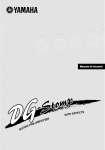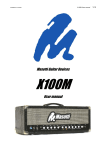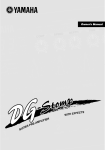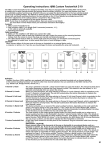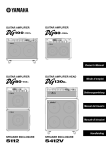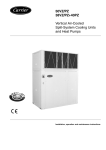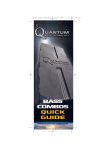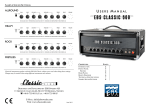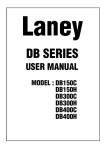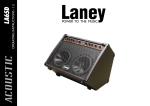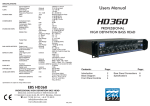Download Engl Savage Special Edition Operator`s manual
Transcript
OPERATOR'S MANUAL G AIN CRUNCH 1 BASS MIDDLE TREBLE TREBLE BAL ANCE REVERB CLEAN VOLUME CRUNCH 1 VOLUME PRESENCE A PRESENCE B SAVAGE BRIGHT CRUNCH BOOST PRESHAPE TR.BAL. ACTIVE CLEAN CRUNCH1 DEPTH BOOST DEPTH BOOST PRES. A/B SPEAKER A/B INPUT G AIN LEAD LEAD BOOST BASS MIDDLE TREBLE TREBLE BA L ANCE REVERB ROUGH / SMOOTH CRUNCH 2 VOLUME LEAD VOLUME CRUNCH2 L EAD special edition REVERB ACTIVE MIDI MODE STANDBY MASTER A POWER MASTER B MASTER A/B CHANNEL TRIODE / PENTODE 1/2 SAVAGE special edition Please, first read this manual carefully! Congratulations! You chose an excellent product, the ENGL SAVAGE special edition, a quality advanced all-tube guitar head that sets a new standard for sound technology and versatility in the high-end sector. This amp is the product of a concentrated effort; all of us here at ENGL invested all our experience and innovative ideas in the design and construction of this amp.You are now the owner of one of these quality heads and we think congratulations are definitely in order: 2 EDMUND ENGL, Product concept and realization, production and assembly line design, mechanical construction and electronic layout (via CAD), soundcheck, production control. HORST LANGER, Idea, concept, technical and electronic design, acoustic research, electronic finishing and author/typist of this operator’s manual, graphics and layout. BEATE AUSFLUG, Procurement, sales and financing Short preliminary description: The ENGL SAVAGE special edition is on the cutting edge of modern guitar technology, it boasts a number of efficient features and operating modes: four channels, Clean, Crunch 1, Crunch 2 and Lead assigned to two main channels, each featuring an individual voicing section. Four gain pots and a separate volume control for each channel allow for precision-tuning between channels. The Rough/Smooth mode selector for the Crunch 2 and Lead channels generates two completely different types of overdrive which produce two distinctive tonal variations: Rough for loads of upper-end grit and powerful bottom-end; Smooth for creamy mids with plenty of punch. This feature plus the four channels lets you access six individual sound modes! Additionally, diverse switching functions allow you to shape the main channels' tonal characteristics to your taste. Furthermore the two poweramp operating modes Triode and Pentode and the option of switching between two different speaker cabinets enhance this amp´s tonal spectrum. The power amp's two voicing sections and two master volume controls have proven to be both practical and effective. These, along with the channels and a several other features, can be selected and accessed via the front panel, a footswitch or a MIDI switching system. By means of the ENGL MIDI Interface (optional), these features can be controlled via a MIDI pedal board and the settings for switching functions can be programmed in up to 99 memory locations. This amp also features a number of signal paths: a passive parallel/serial (!) FX loop for each main channel or a switchable master FX loop, a variable balanced line out featuring speaker simulation and an overload LED, as well as selectable 4, 8 and 16 Z speaker outputs for numerous cabinet connection options. Yet another handy tool is the "ENGL Impedance Test and Cable Check System": This unique feature helps you to check speakers´ impedances and cables equipped with 1/4" plugs! The integrated ECS (Emergency Circuit System) protects the amp from damage due to power tube defects/failure and ensures the amp continues to function at reduced power until the failed tube can be replaced. Superior craftsmanship and finishing, quality components are what this device is all about. However, keep in mind that a few precautions will radically extend tube life! PLEASE NOTE: Read the Operator’s Manual carefully and thoroughly, especially the following Handling and Care section as well as the framed guidelines. Avoid operating errors and potential damage to the amp by heeding the guidelines and cautionary remarks in this manual. It also covers a few convenient pointers and interesting tips on several functions. These are located under the respective function´s description. This manual covers all the features, operational guidelines, technical specifications and many helpful hints and tips. It should answer all your questions, so keep it in a safe place and refer to it when necessary. Handling and Care Protect the amp from mechanical knocks (tubes!). Let the amp cool down before you transport it (app.10 minutes). Tubes need about 20 seconds to warm up after you switch the power on, and a few minutes more before they reach their full power capability. Avoid storing the amp in damp or dusty rooms, they are hard on jacks, switches and potentiometers. Make sure air can circulate at the front and top of the amp to allow for adequate cooling (increases component life). Never operate the amp without an adequate load. Replace tubes with select ENGL replacement tubes (special selection criteria) to avoid microphonic properties, undesirable noise and unbalanced response. Please also note the item printed on page 13! 3 FRONT PANEL Explanation: *MCH 1 (Main Channel 1) Pushbuttons/Controls marked with *MCH 1 are assigned to Main Channel 1 and are only active in this channel. *MCH 2 (Main Channel 2) Pushbuttons/Controls marked with *MCH 2 are assigned to Main Channel 2 and are only active in this channel. *P.A. Section (Power Amp Section) Pushbuttons/Controls marked with *P.A.Section are assigned to the poweramp section and are only active there. 1 BRIGHT *MCH 1; Alters the EQ by boosting the upper treble range in the Main Channel 1; effectiveness decreases at higher GAIN (1) settings. Tip: For a crisp glassy tone, set the Bright switch to the On position. This setting boosts the treble response of muddy pickups. 2 PRESHAPE *MCH 1; Two different filtering characteristics can be preset: Off position: cuts the midrange. ON position (pushed in): boosts the low midrange. Tip: The Off-positions is ideal for bright, funky chords and riffs complete with a tight bottom end. The activated function delivers a very warm and fat tone. You can also use this feature to equalize the amp's sound characteristics to adapt it to different pickups. 3 GAIN *MCH 1; Input sensitivity control for the Clean and the Crunch 1 channels. Tip: GAIN settings depend on what type of pickups are installed in your guitar. The recommended setting for humbuckers or active pickups lies between the 11 and 2 o’clock positions and 1 to 4 o’clock for single coils for a pure clean response. Moreover, increased gain will produce a touch of overdrive in the preamp. If your pickups are of the ultra-high output variety you may have to back off the guitar’s volume to achieve a truly clean tone. It may be advisable to reduce the Bass level when operating with high gain and volume levels to achieve a Clean response. 4 CRUNCH BOOST *MCH 1; Boosts the signal in the Crunch 1 channel, with primary emphasis on the bottom end. Tip: For example, this feature can be used in combination with the Preshape (2) control to achieve a tonal balance between the Clean and the Crunch 1 channels: Preshape Off -> Crunch Boost On; Preshape ON -> Crunch Boost Off. Other applications: You can select alternative sounds featuring a heavier bottom end for pickups with thin bass response or shape the response to suit your taste. 5 CRUNCH1 *MCH 1: Additional sensitivity control feature for the Crunch 1 mode; allows you to increase and decrease the signal level for the Crunch 1 channel and balance its gain in relation to the Main Channel´s Gain (3) setting. Tip: The Crunch 1 channel is ideal for marginal to medium distortion. Response is extremely dynamic; mildly overdriven sounds can be attained at Crunch 1 settings between 11 and 2 o'clock, depending on the setting of the Gain control (3). Furthermore you have the option of dialing in a different Clean sound in the Crunch 1 channel by adjusting this control to the 9 o´clock position. By using the Crunch Boost switch and the Treble Balance control, you can shape the tone to provide a contrast to the Clean channel´s tone. 6 BASS *MCH 1; Bottom end voicing control for the Main Channel 1 (Clean and Crunch 1). Tip: To get an idea of this amp's capabilities, we suggest you set all control pots to the 12 o'clock position and then adjust the sound according to your taste, the connected speakers and the room's ambience. The operating mode of this EQ is passive; it is located in the preamp stage and therefore affects the FX Loop´s send signal. 4 7 MIDDLE *MCH 1; Mid-range voicing control for the Main Channel 1 (Clean and Crunch 1). Tip: (see section 6, Tip!) 8 TREBLE *MCH 1; Upper range voicing control for the Main Channel 1 (Clean and Crunch 1). Tip: (see section 6, Tip!) 9 TREBLE BALANCE *MCH 1; Treble balance control, operable in the Crunch 1 channel only. This control allows you to boost or cut the high end in relation to the amount of treble determined by the Treble (8) -setting. Activate this control by means of the Treble Balance Active (10) pushbutton. Tip: If you have dialled in a very bright Clean sound (Treble control at the 3 o'clock position or higher),you may want to reduce the amount of treble for the Crunch 1 channel to avoid a shrill Crunch sound. This feature can also be helpful in avoiding unintentional feedback between the speaker and the guitar. 10 TREBLE BALANCE ACTIVE *MCH 1; This pushbutton activates the Treble Balance (9) control in the On position (pushed in). Tip: If you want the treble response to be identical in both the Crunch 1 and the Clean channels, leave this pushbutton in the Off position; now the Treble Balance (9) control is inactive. Also use this setting if you prefer to adjust the treble via your guitar's tone control. 11 REVERB *MCH 1; Reverb control, adjusts the portion of the reverb signal and increases reverb intensity in the main channel 1 when you rotate it clockwise; the reverb can be switched on via the Reverb Active (22) pushbutton. The red LED above this pushbutton indicates the reverb is active. The reverb can also be switched via the MIDI Interface Port (45), or the footswitch jack (49). 12 CLEAN VOLUME *MCH 1; Volume control for the Clean channel. (in front of the FX loop, affects the Send level) 13 CLEAN/CRUNCH 1 *MCH 1; Channel selector pushbutton for switching between Clean and Crunch 1 modes. Off position: the Clean channel is active; On position (pushed in): the Crunch 1 channel is active when the main channel selector pushbutton (39) is in the Off position (Main Channel 1) in both cases. An LED located next to the respective channel's volume control illuminates when the channel is activated. Clean channel: green LED, Crunch 1 channel: yellow LED. This feature can also be switched via the MIDI Interface Port (45), or the footswitch jack (46); the channel selector pushbutton is deactivated once a footswitch is connected to the footswitch jack (46). 14 CRUNCH 1 VOLUME *MCH 1; Volume control for the Crunch 1 channel. (in front of the FX loop, affects the Send level) 15 MIDI MODE This red LED illuminates when the ENGL MIDI Interface is connected and activated; the LED flashes when the amp is operating in the MIDI mode. Tip: The ENGL MIDI Interface offers even more comfortable handling features and loads of interesting combinations. This interface allows you to switch the defined functions via a MIDI stage board. You can also save diverse sound combinations as presets in up to 99 MIDI memory locations, assign polychannels 1-8 via the interface and control another ENGL device equipped with an MIDI Interface Port; e.g. an ENGL rack stereo power amp, type 930 (-> for a stereo setup!). 16 PRESENCE A *P.A.Section; Treble control A in the power amp. Tip: Use two controls A and B and the respective Depth Boost pushbuttons to adjust two different sound settings in the poweramp. This feature enhances the sound variations of the amp because you can assign both EQs to every channel and to the Rough and Smooth modes. Another application is a combination with two different speaker cabinets (a seperate tone control setting for cabinet A and B) or different sound settings for Triode and Pentode operation modes. 5 17 DEPTH BOOST *P.A.Section; Boosts the bottom end in the power amp; this pushbutton is assigned to the Presence A control. Tip: (see section 16, Tip!) 18 PRESENCE A/B *P.A.Section; Switches between Presence A and Presence B; the active Presence control is identified by the illuminated LED next to the respective control. Red LED: Presence A (16) and Depth Boost (17); green LED: Presence B (19) and Depth Boost (20), This feature can also be switched via the MIDI Interface Port (45), or the footswitch jack (48); the channel selector pushbutton is deactivated once a footswitch is connected to the footswitch jack (48). 19 PRESENCE B *P.A.Section; Treble control B in the power amp Tip: (see section 16, Tip!) 20 DEPTH BOOST *P.A.Section; Boosts the bottom end in the power amp; this pushbutton is assigned to the Presence B control. Tip: (see section 16, Tip!) 21 SPEAKER A/B (=OUTPUT A/B) *P.A.Section; This pushbutton switches between speaker output A (74) and speaker output B (75), if speakers are connected to both output jacks. The red LED above the pushbutton indicates "speaker B active". This feature can also be switched via the MIDI Interface Port (45), or the footswitch jack (49); the pushbutton is deactivated once a footswitch is connected to the footswitch jack (49). IMPORTANT: When operating the amp together with one speaker cabinet, always connect it to Output A/ Master (74)! If no cabinet is connected to Output B (75), the switching function is disabled. Ensure cabinets or speaker systems bear the same impedance at Output A and Output B: e.g. cabinet at Output A =8 ohms and cabinet at Output B=8 ohms! Never operate the poweramp without a sufficient load! Tip: The speaker switching feature is ideal for driving two speaker cabinets with different response. One recommended combination would be a closed 4 x 12" cabinet together with an open 4 X 10" cabinet. This feature offers a number of interesting sound variations. 22 REVERB ACTIVE This pushbutton activates the integrated spring reverb system. A red LED above the the pushbutton indicates the reverb is active. This pushbutton's primary significance is during MIDI programming via the MIDI Interface (if connected). Use it to assign the internal reverb signal to different MIDI presets. Adjust the reverb portion with the respective Reverb controls in both main channels. Reverb can also be switched via the MIDI Interface Port (45), or the footswitch jack (49); the pushbutton is deactivated once a footswitch is connected to the footswitch jack (49). 23 INPUT Unbalanced 1/4" input jack 24 GAIN *MCH 2; Input sensitivity control, functions as pre-gain for the Crunch 2 and the Lead channel and defines the amount of (preamp-) overdrive in the Crunch 2 channel. Tip: The Crunch 2 channel sounds more refined and the mid response is harder than in Crunch 1. It is ideal for playing fast riffs. In conjunction with higher Gain settings and powerful pickups, this channel can be suitable for playing lead. 25 LEAD BOOST *MCH 2; Boosts the degree of distortion in the Lead channel, with primary emphasis on the bottom end. Tip: When you are using high Gain and Lead settings, we recommend that you leave this pushbutton in the Off position to avoid a spongy bass response. In Lead mode with medium Gain settings (Gain and Lead controls between the 11 and 1 o'clock's position), the activated Lead Boost delivers softer mids, more bass punch and plenty of sustain. 6 26 LEAD *MCH 2; Controls the amount of distortion in the Lead mode; the Gain (23) and Lead controls are used to define the relationship between the Crunch and Lead signals. CAUTION: Extremely high gain and volume levels in the Crunch and Lead mode can produce strong feedback. Avoid feedback squeals, they lead to hearing loss and damaged speakers! 27 BASS *MCH 2; Bottom end voicing control for the Main Channel 2 (Crunch and Lead). Tip: To get an idea of this amp's capabilities, we suggest you set all control pots to the 12 o'clock position and then adjust the sound according to your taste, the connected speakers and the room's ambience. The operating mode of this EQ is passive; it is located in the pramp stage and therefore it affects the send signal at the FX Loop. 28 MIDDLE *MCH 2; Mid-range voicing control for the Main Channel 2 (Crunch and Lead). Tip: (see point 26, Tip!) 29 TREBLE *MCH 2; Upper range voicing control for the Main Channel 2 (Crunch and Lead). Tip: (see point 26, Tip!) 30 TREBLE BALANCE *MCH 2; Treble balance control, operable in the Smooth mode only. This control allows you to boost or cut the high end in relation to the amount of treble determined by the Treble (28) -setting. 31 ROUGH/SMOOTH *MCH 2; Switches between two completely unique overdrive characteristics in the Crunch 2 and Lead channels. Rough: emphasis on high and low ends. Smooth: emphasis on midrange, suppresses the gritty upper frequencies. A red LED above the pushbutton denotes the Smooth mode is active. This feature can also be switched via the MIDI Interface Port (45), or the footswitch jack (47); the channel selector pushbutton is deactivated once a footswitch is connected to the footswitch jack (47). Tip: The Rough sound character (heavy) is great for rhythm playing with a pronounced bottom end and gritty, biting highs. You should use the Bass knob (27) and the Depth Boost buttons (17 or 20) sparingly in conjunction with this feature (especially if you connect a 4 x 12" cabinet). The Smooth sound character is most effective for lead-playing. In spite of its creamy tube tone, its pronounced mids deliver enough punch to cut through! Try Presence settings between 11 and 3 o´clock and activate the Depth Boost. Extremely high gain and volume levels can produce strong feedback between the speakers and your guitar´s pick ups. Cut back on the Gain, Treble and Presence settings to avoid undesirable feedback. 32 REVERB *MCH 2; Reverb control, adjusts the portion of the reverb signal and increases reverb intensity in the main channel 2 if you rotate it clockwise; the reverb can be switched on via the Reverb Active (22) pushbutton. The red LED above this pushbutton indicates the reverb is active. The reverb can also be switched via the MIDI Interface Port (45), or the footswitch jack (49). 33 CRUNCH 2 VOLUME *MCH 2; Volume control for the Crunch 2 channel. (in front of the FX loop, affects the Send level) 34 CRUNCH 2/LEAD *MCH 2; Channel selector pushbutton for switching between Crunch 2 and Lead modes. Off position: the Crunch 2 channel is active; On position (pushed in): the Lead channel is active when the main channel selector pusbutton (39) is in the On position (Main Channel 2) in both cases. An LED located next to the respective channel's volume control illuminates when the channel is activated. Crunch 2 channel: yellow LED, Lead channel: red LED. This feature can also be switched via the MIDI Interface Port (45), or the footswitch jack (47); the channel selector pushbutton is deactivated once a footswitch is connected to the footswitch jack (47). 35 LEAD VOLUME *MCH 2; Volume control for the Lead channel. (in front of the FX loop, affects the Send level) 7 36 MASTER A *P.A.Section; Master volume A for power amp output. Tip: The two Master volume controls offer a few practical applications: adjust two different volume levels in the poweramp and assign them to the four channels and the Rough and Smooth modes. Another application is a combination with the two poweramp operating modes Triode and Pentode: Set the desired volume level with one Master for the Pentode mode. With the other Master, adjust a very high level that generates a great overdrive sound in poweramp Triode mode. 37 MASTER A/B *P.A.Section; Switches between Master A and Master B; the active Master control is identified by an LED next to the respective control, red LED: Master A (36); green LED: Master B (38). This feature can also be switched via the MIDI Interface Port (45), or the footswitch jack (48); the channel selector pushbutton is deactivated once a footswitch is connected to the footswitch jack (48). 38 MASTER B *P.A.Section; Master volume B for power amp output. Tip: (see point 36, Tip!) 39 CHANNEL Main Channel selector pushbutton; selects Main Channel 1 or 2 and, depending on the other channel selector pushbutton settings (13 and 34). It activates the Clean, Crunch 1, Crunch 2 or Lead channels. Off position: Main Channel 1 (Clean or Crunch 1), On position (pushed in): Main Channel 2 (Crunch 2 or Lead). This feature can also be switched via the MIDI Interface Port (45) or the footswitch jack (46): the channel selector pushbutton is deactivated once a footswitch is connected to the footswitch jack (46). 40 TRIODE PENTODE *P.A.Section; Switches between Triode and Pentode operating modes in the poweramp. The red LED above the pushbutton denotes Pentode mode. This feature can also be switched via the MIDI Interface Port (45). Tip: Use the both poweramp modes as follows: 1. To reduce the output power in Tride mode to approx. 1/2 of the Pentode power. Now you can generate excellent poweramp overdrive at a reasonable volume level. 2. The two modes generate a different spectrum of overtones which alters the sound: In combination with the four channels and sound modes, the two poweramp operating modes offer a wide range of sound variations. The Triode mode has pronounced mids and sounds warm and creamy. The close the poweramp gets to to the overdrive threshold, the more intense this effect becomes. Pentode mode emphasizes bass and treble response, the sound character becomes somewhat more brittle and refined. 41 STAND BY Poweramp standby switch. Use this feature during a break; the amp is ready to perform immediately because there delay while the tubes heat up. In order to conserve energy, we recommend that you switch the amp off (42) during a lengthy break. 42 POWER AC power on/off. 8 REAR PANEL 43 AC SOCKET Connect AC cord here ATTENTION: Ensure you use an intact AC cord with an insulated plug only! Before you power the amp up, ensure the voltage value printed beside the AC socket corresponds to the available current. 44 AC FUSE BOX Contains mains fuse (rear chamber) and spare fuse (front chamber) NOTE: Ensure replacement fuses bear identical ratings (refer to the table)! 45 MIDI INTERFACE PORT You can connect the ENGL MIDI Interface to this jack (Sub D, 25 pins) and then execute channel selection functions (13), (34), (39), Rough/Smooth mode (31) selection, Presence A/B (18) switching, Master A/B (37) switching, speaker A/B (21) switching, Reverb Active (22) and Triode/Pentode mode (40) via MIDI. You can also save the switch settings in up to 99 memory locations (MIDI presets) of the MIDI inteface. The MIDI Mode LED (15) illuminates when the interface is active. Flashing LEDs denote the amp is operating in the MIDI mode. A very detailed operating manual is included with the MIDI Interface. 46 FOOTSWITCH: CHANNEL; CLEAN/CRUNCH 1 1/4" stereo jack for connecting a dual footswitch; it executes the following functions: 1. Main channel selection, Main Channel 1/Main Channel 2 (mono terminal). 2. Channel selection: Clean/Crunch 1 (stereo terminal). Tip: All switching functions that can be switched via footswitch can also be executed via a Looper/ switcher or other MIDI device that features 8 freely-programmable switching inputs. Depending on the type of MIDI device, you may have to split the Footswitch stereo jacks into eight mono jacks. Each switching function requires a mono or stereo contact (see 46, 47, 48 and 49 for pin assignments) and the ground! NOTE: If the switching and signal grounds are identical in the MIDI device, then you may encounter a gound loop, especially if the amp and device (e.g. FX processor) exchange signals! 47 FOOTSWITCH: CRUNCH 2/LEAD; ROUGH/SMOOTH 1/4" stereo jack for connecting a double footswitch executes the following functions: 1. Channel selection: Crunch 2/Lead (mono terminal). 2. Sound mode switching Rough/Smooth (stereo terminal). Tip: (see point 46, Tip!) 48 FOOTSWITCH: MASTER A/B, PRESENCE A/B 1/4" stereo jack for connecting a dual footswitch; it executes the following functions: 1. Switching between Master A/B control (mono terminal). 2. Switching between Presence A/B control (stereo terminal). Tip: (see point 46, Tip!) 49 FOOTSWITCH: REVERB; OUTPUT A/OUTPUT B (= SPEAKER A/B) 1/4" stereo jack for connecting a dual footswitch; it executes the following functions: 1. Reverb on/off (mono terminal). 2. Switching between the two speaker/poweramp Outputs A and B (stereo terminal). Tip: (see point 46, Tip!) 50 FX LOOP STATUS This switch assigns the two FX loops to the two Main Channels. Off position: Master Loop (common FX loop), activates the FX Loop Channel 1 (common signal processor for all channels); On position (pushed in): Channel 1/Channel 2 selection (separate FX loops), FX Loop Channel 1 is active for Main Channel 1, FX Loop Channel 2 is assigned to Main Channel 2 (different signal processors for the two main channels). Tip: For example, you can use this feature to insert a chorus to Main Channel 1 and a delay with a noise gate to Main Channel 2; different effect levels can be adjusted via the separate Balance controls. When you insert a multi-FX processor, activate the Master FX Loop and assign the effects of your choice to the respective channels and sound modes of the amplifier. Effects assignment has to be programmed at the 9 FX device itself. With this application, you will find it very comfortable to control the amp via MIDI and the ENGL MIDI Interface: All of the amp's MIDI functions can be switched at the same time with the MIDI FX processor's effects via a MIDI footpedal! 51 SEND Signal output for the Master Loop or Main Channel 1´s FX Loop (Depending on FX Loop Status pushbutton (50) setting). Connect this output to a signal processor’s input/return jack via a shielded cable with 1/4" plugs. 52 RETURN Signal input for the Master Loop or Main Channel 1´s FX Loop (Depending on FX Loop Status pushbutton (50) setting). Connect this input to a signal processor’s output/send jack via a shielded cable with 1/4" plugs. 53 BALANCE FX mix control for the Master Loop or Main Channel 1´s FX Loop (Depending on FX Loop Status pushbutton (50) setting): Rotate the knob to the Dry position for the dry amp signal, i.e. no effect on the signal. Turn clockwise to blend in an effect connected to the loop with the dry signal (parallel/passive). When the control is set all the way to the Effect position, only the wet signal, i.e. the signal sent from the FX device, is routed to the power amp (serial/passive). NOTE: If you do not connect an effects processor to this loop, set this control to the Dry position! 54 SEND Signal output for the Main Channel 2´s FX Loop (only active when FX Loop Status pushbutton (50) setting is set to CH 1/CH 2!). Connect this output to a signal processor’s input/return jack via a shielded cable with 1/4" plugs. 55 RETURN Signal input for the Main Channel 2´s FX Loop (only active when FX Loop Status pushbutton (50) setting is set to CH 1/CH 2!). Connect this input to a signal processor’s output/send jack via a shielded cable with 1/4" plugs. 56 BALANCE FX mix control for the Master Loop or Main Channel 2´s FX Loop (only active when FX Loop Status pushbutton (50) setting is set to CH 1/CH 2): Rotate the knob to the Dry position for the pure amp signal, i.e. no effect on the signal. Turn clockwise to blend in an effect connected to the loop, to the dry signal (parallel/passive). At the Effect position, only the wet signal, i.e. the signal sent from the FX device is fed to the power amp (serial/passive). NOTE: If you do not connect an effects processor to this loop, set this control to the Dry position! 57 POWER TUBE FUSE Fuse (refer to the description of the E.C.S. on page 13) for the left power tube (the far left tube when viewed from the rear of the chassis); the LED above the fuse illuminates when this fuse is blown. Replacement fuses (160 mAM) are located at the housing´s rear panel. 58 POWER TUBE FUSE Fuse for the second power tube (second from left); the LED above the fuse illuminates when this fuse is blown. Replacement fuses (160 mAM) are located at the housing´s rear panel. 59 POWER TUBE FUSE Fuse for the third power tube (second from right); the LED above the fuse illuminates when this fuse is blown. Replacement fuses (160 mAM) are located at the housing´s rear panel. 60 POWER TUBE FUSE Fuse for the right power tube (the far right tube); the LED above the fuse illuminates when this fuse is blown. Replacement fuses (160 mAM) are located at the housing´s rear panel. 10 61 CABLE RETURN Connect one end of a cable with 1/4" plugs to this jack, the other end to jack 62. Only Mono cables can be tested with this feature. Tip: This test circuit is a very useful tool: You are able to test speaker cables as well as guitar cables and patch cables (only the mono wire is tested!) for FX device connections. Due to the higher resistance of longer cables you may find that the 12 Z LED instead of the 8 Z LED indicates that the cable is O.K. 62 TEST JACK Connect a speaker cabinet(s) to this jack for an impedance check. For the cable test, insert one end of the cable to this jack. IMPORTANT: Before testing a cable, make sure that the other end of this cable is not connected to a poweramp output; this may damage the test circuit. Even a cabinet that features a Thru jack may not be connected to a poweramp output. It is OK to connect it to another. Disconnect the cable or the cabinet after the test to avoid unnecessary strain on the internal power circuit. PLEASE NOTE: During the impedance check, you may find that several LEDs illuminate or flicker at the same time. Possible causes: the connection between the plug and the jack is faulty or a high level of peripheral noise is generating voltage in the speakers that influences the test circuit. Due to the measuring method, deviations in values are possible. The speaker's DC resistance provides delivers an approximation of a the exact value. This circumstance explains why you might encounter a discrepancy between the displayed and the true value. When you are sure about the impedance of a cabinet (or of several interconnected cabinets), use this value to set the impedance selector (76) to the correct position. In practice,the displayed value should not vary more than one LED bar from the true value. Use thick, short cables for the impedance test to avoid faulty measurements due to higher cable resistance. 63 < 4 Z; CABLE SHORT CIRCUIT This red LED flashes to indicate the following results during the impedance check: an impedance lower than 4 ohms, possibly a shortcircuit in the connector cable (test the cable separately!), or a shortcircuit inside the cabinet. During the cable check, it indicates a shortcircuit between the wires or in one of the plugs. 64 4 Z This green LED indicates an (overall) impedance of 4 ohms during the impedance check. 65 6 Z This yellow LED indicates the following results during the impedance check: a relatively unusual (overall) impedance of 6 ohm. Possible cause: A speaker's tolerance (it may be an 8 ohm system), faulty cables, or poor connections between plugs and jacks (in this case, it may be a 4 ohm system), or a parallel circuit consisting of three 16 ohm speakers. 66 8 Z; CABLE O.K. This yellow LED indicates the following results during the impedance check: an (overall) impedance of 8 ohms. During the cable check, it indicates cable is intact. 67 12 Z This yellow LED indicates the following results during the impedance check: a relatively unusual (overall) impedance of 12 ohms. Possible cause: A speaker's tolerance (it may be a 16 ohm system), faulty cables or poor connections between plugs and jacks (in this case it may be an 8 ohm system), or a serial circuit consisting of a 4 ohm and an 8 ohm speaker. 64 4 Z This green LED indicates an (overall) impedance of 16 ohms during the impedance check. 69 > 16 Z; CABLE BREAK This red LED flashes to indicate the following results during the impedance check: an impedance greater than 16 ohms, possibly a break in the connector cable (test the cable separately!), or a break the cabinet's internal wiring. During the cable check, it indicates a break in the wires or in one of the plugs. inside the cabinet. During the cable check a break in the wires or in one of the plugs. 11 70 LEVEL Signal level control for the frequency-corrected line output; use it to match the amp’s signal level at the Line output to the mixing console or recorder’s input. Tip: The Line Out's output level is influenced by the following factors: 1. in the PREAMP setting, by the input level (Gain, Crunch, Lead), the Volume control settings for the various channels and to some degree by voicing control settings. 2. in the Poweramp setting, as above with the addition of the Master settings. First dial in the desired sound combination at the front panel. Then adjust levels for FX devices and signal processors (if connected). Now use the Level control to adjust the level. The Line output is not overloaded until the Overload LED illuminates brightly and continuously. You can push the level up to this point to match a mixer desk's or recorder's input level requirement. Use the respective device's input sensitivity or gain control to fine-tune level adjustments. 71 LINE OUT STATUS Selects the Line output mode. Off position: the Line signal is routed from the poweramp output, (Stand By activated!), On position (pushed in): the Line signal is routed from the SAVAGE 's preamp. Tip: The SAVAGE's preamp and power amp supply two different signals: The Presence control, the Depth Boost switch, the power tubes and the output transformer in the power amp stage influence the final tone. You may need to adjust the voicing controls at your amp, mixer desk or recorder when identical tones are desirable. 72 OVERLOAD This LED denotes the Line output is overloaded; in this case, reduce the signal’s level via the Level control. 73 LINE OUT BALANCED & FREQU.-COMPENSATED The frequency-corrected, balanced Line output jack (XLR). (Pin 2 and 3 signal, Pin 1 = N.C. ). Its signal simulates a 4 x 12" speaker cabinet. 74 POWERAMP OUTPUT A; MASTER Poweramp output A or Master output. You must connect a speaker cabinet to this jack before you operate (activate) the poweramp. IMPORTANT: When you operate the amp with one cabinet (or even when you connect a combination of cabinets), always connect the cabinet/cabinets to Output A/Master! 75 POWERAMP OUTPUT B Output B of the poweramp. Select this output via the Speaker A/B pushbutton (21), when you have also connected a cabinet to this output. VERY IMPORTANT: Never operate the power amp without a sufficient load, otherwise you may damage or destroy the power amp! Make sure your cabinet's specifications match the respective output's specs! Also make certain you have selected the proper impedance at the impedance selector! When operating the amplifier with cabinets connected to Output A and Output B, ensure the cabinets or speaker systems bear the same impedance at Output A and Output B: e.g. cabinet connected to Output A = 8 ohms and cabinet connected to Output B = 8 ohms! If you want to feed a signal from the preamp (e.g. via Line Out) without driving a speaker cabinet, ensure you switch the amp to Stand By (41) mode! 76 IMPEDANCE SELECTOR (see next page!) 12 76 IMPEDANCE SELECTOR Impedance selector for the poweramp outputs A and B. Set the required impedance: 4, 8 or 16 ohms. The selected impedance values are identical at Output A and Output B! If necessary use a screwdriver for the adjustment. Refer to the following table for permitted speaker cabinet combinations. (Z: Ohm; p: parallel circuit i.e. thru jack at the cabinet; <=>: reverse setup is also permitted). Setting at the selector: Output A: Output B: 4 Ohm 1x4Z 2x8Zp 1x4Z 2x8Zp 2x8Zp N.C. N.C: 1x4Z 1x4Z 2x8Zp 8 Ohm 16 Ohm 1x8Z 2 x 16 Z p 1x8Z 2 x 16 Z p 2 x 16 Z p 1 x 16 Z 1 x 16 Z <=> <=> N.C. N.C. 1x8Z 1x8Z 2 x 16 Z p N.C. 1 x 16 Z Attention! Please read the following! This guitar amplifier can produce high volume levels. Exposure to high volume levels may cause hearing damage! Leave tube replacement and power amp biasing to qualified professional. Be sure the unit is switched off and unplugged! Caution! Tubes can get very hot and cause skin burns. Always use high quality cables. Never operate the amp through an ungrounded outlet! Never bridge a defective fuse and be sure replacement fuses feature identical ratings! Pull the AC mains plug before replacing fuses! Never open the chassis or attempt repairs on your own. Consult qualified service personnel! Never expose the amplifier to extreme humidity or moisture! Please read the instructions carefully before operating the unit! Only operate the amplifier in a manner it is designed for and therefore read this operational instructions! 13 Technical Data Rated power: 100 W Power Outlet Impedances : 4, 8 or 16 ohms Minimum Input level: - 40 dB Maximum Input Level: - 3 dB Effects loop: - 10 dB (average), - 3 dB (max.) + 3 dB (max.) + 3 dB (max.) SEND RETURN LINE output: Levels are based on 0db => 1 V eff, measured at 1kHz. Tubes: V1 -> ECC83/7025 F.Q. (First Quality) V2, V3, V4, V5 -> ECC83/12AX7 selected V6 -> ECC83/12AX7 standard V7, V8, V9, V10 -> 5881 or 6L6 GC matched set Fuses: AC mains: 230 Volts 100 and 120Volts external 2,5 AM 5 AM (medium) internal 3,15 AT 6,3 AT (slow) Power tubes (ECS): 4 x 160 mAM Dimensions: (l x h x d) 71 x 27 x 29 cm (28 x 10,6 x 11,4 ") Weight: app. 22 kg We reserve the right to make unannouced technical upgrades. Tube array: Bulb 15 W max. Bulb 15 W max. V7 V1 V2 V3 V8 V4 V9 V5 V 10 V6 Output Transformer Power Transformer E C S (Emergency Circuit System): This circuit ensures the amplifier does not shut down completely when a single power tube fails. The amp continues to perform at reduced power, depending on the type of defect. Gas developing in the power tubes can cause a momentary short circuit. The fuse activates, but the amp is not shut down! Often the tube absorbs the developed gas, and is operable after a short circuit. Sometimes the problem can be rectified by replacing the fuse, but if the new fuse activates as well, the defective power tube needs to be replaced. 14 FRONT PANEL 1 2 3 4 G AIN 5 6 7 8 9 CRUNCH 1 BASS MIDDLE TREBLE TREBLE BAL ANCE 10 11 12 13 14 15 16 17 18 19 20 21 22 CLEAN VOLUME REVERB CRUNCH 1 VOLUME PRESENCE A PRESENCE B SAVAGE BRIGHT CRUNCH BOOST PRESHAPE TR.BAL. ACTIVE CLEAN CRUNCH1 DEPTH BOOST DEPTH BOOST PRES. A/B SPEAKER A/B special edition REVERB ACTIVE MIDI MODE INPUT G AIN LEAD BASS MIDDLE TREBLE BA L ANCE TREBLE LEAD BOOST 23 REVERB CRUNCH 2 VOLUME ROUGH / SMOOTH 24 25 26 27 28 29 LEAD VOLUME MASTER A 32 33 34 35 36 MASTER A/B CHANNEL TRIODE / PENTODE 1/2 37 38 39 40 REAR PANEL VOLTAGE 5A 2,5 A REPLACE FUSE ONLY WITH SAME TYPE AND RATING ! ! CAUTION: 42 IMPEDANCE TEST & CABLE CHECK SYSTEM BEFORE YOU CONNECT SPEAKERS, CABINETS OR CABLES TO THESE JACKS, ENSURE THEY ARE NOT CONNECTED IN ANY KIND TO A POWERAMP OUTPUT ! 120 W All-tube Guitar Amp Head SAVAGE special edition - TYPE 660 DO NOT OPEN ! RISK OF ELECTRIC SHOCK ! DO NOT EXPOSE THIS EQUIPMENT TO RAIN OR MOISTURE ! MADE IN GERMANY Amp-Design by Horst Langer Optically refined by: CLARK / Meinerz WIRED FOR: 230 VOLT 41 61 62 63 65 67 69 64 66 68 CAUTION ! FUSED 100-120 V 220-240 V POWER MASTER B CRUNCH2 L EAD 30 31 STANDBY 4z 6z CABLE SHORT CIRCUIT CABLE RETURN MASTER LOOP FX LOOP CHANNEL 1 FOOTSWITCHES CONNECTORS <4z 8z 12 z 16 z 76 8 OHMS 4 OHMS 16 OHMS >16 z CABLE O.K. CABLE BREAK TEST JACK FX LOOP CHANNEL 2 IMPEDANCE SELECTOR POWERAMP OUTPUT MIDI INTERFACE PORT OVERLOAD CH 1/ CH 2 PREAMP SERIAL NUMBER: 095660 43 44 CAUTION ! CONNECT TO MIDI INTERFACE ONLY ! USE PORT A ! 45 CHANNEL 1 / CHANNEL 2 CLEAN / CRUNCH 1 CRUNCH 2 / LEAD ROUGH / SMOOTH MASTER A / MASTER B PRESENCE A / PRESENCE B REVERB ACTIVE OUTPUT A / OUTPUT B 46 47 48 49 MASTER LOOP FX LOOP STATUS DRY EFFECT POWER DRY EFFECT AMP 160 mA SEND RETURN 50 51 52 BALANCE 53 SEND RETURN 54 55 BALANCE 56 160 mA 160 mA 160 mA POWER TUBE FUSES 57 58 59 60 LEVEL LINE OUT STATUS LINE OUT BALANCED & FREQ.-COMPENSATED 70 71 72 73 OUTPUT A OUTPUT B MASTER CAUTION: IF OPERATING ONE CABINET, CONNECT IT TO OUTPUT A MASTER ! 74 75

















